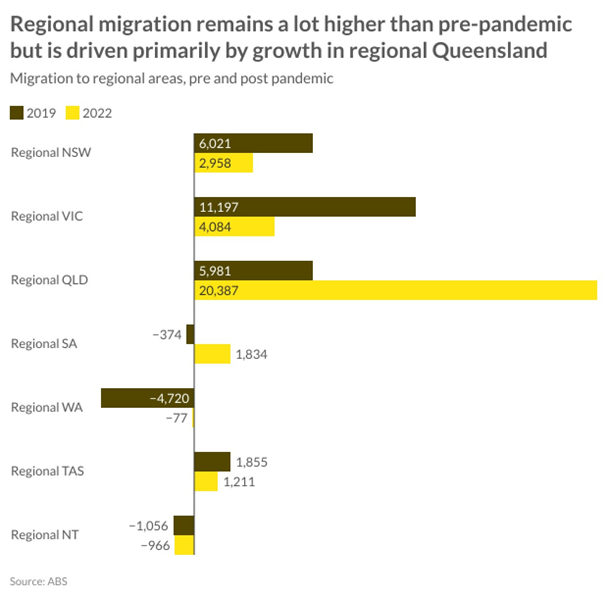Despite decades of government intervention to try to get more people to move to regional Australia, it was the pandemic that led to the biggest shift of people from capital cities to regional Australia. The pandemic is now over so was this shift temporary? Or did it lead to a more permanent shift in where Australians are choosing to live?
Data on population movement to regional areas is patchy. There is a good time series up to 2020 but then a gap in 2021, likely as a result of a recalibration with the Census of Population and Housing undertaken in that year. The series starts up again in 2022. To see whether the regional migration that went on during the pandemic was sustainable, we have taken a look at what migration to regional Australia was before the pandemic in 2019 and then following in 2022.

The pandemic driven movement of people to regional Australia was an acceleration of a trend that was already occurring in many parts of Australia. A desire for affordability and lifestyle were already pushing many people out of Sydney and Melbourne into regional areas that are within commuting distance from these cities such as Wollongong and Bendigo.
Comparing pre-pandemic to post, the net number of people moving to regional NSW and Victoria has declined. In these regional areas however it is the number of people moving away that is seeing the biggest increase, there are still relatively high numbers of people arriving. This likely reflects a return to pre-pandemic life for those that made the move, possibly driven by a need to return to the workplace
While regional Victoria and NSW saw fewer people making the move post pandemic compared to before, the opposite was true in regional Queensland and South Australia. Queensland is now seeing particularly strong levels of regional migration, dominating total regional migration across Australia. Although a comparatively smaller number, regional South Australia has moved from losing people in regional areas to being a net attractor.
At a small area level, these changes to population movements to regional areas have not surprisingly impacted house prices. Both Victoria and Tasmania saw relatively high levels of movement to regional areas pre-pandemic and the top price growth areas are overwhelmingly in these states. Launceston and the north-east of Tasmania saw the biggest increase with prices jumping 19.3 per cent in 2019. In Victoria, topping the list was the Latrobe-Gippsland area.
Post pandemic, the list of top growth regions is dominated by regional areas in Queensland and South Australia. Topping the list is the Darling Downs – Maranoa region, directly west of Brisbane. Coming in second is the Barossa-Yorke-Mid North region, east of Adelaide. Many of the regions on the list however are rich agricultural or mining regions and less so holiday destinations. This shows that the regional movement that is now occurring is a little bit about people wanting to make a sea or tree change, but more so about strong performing economic growth areas.
